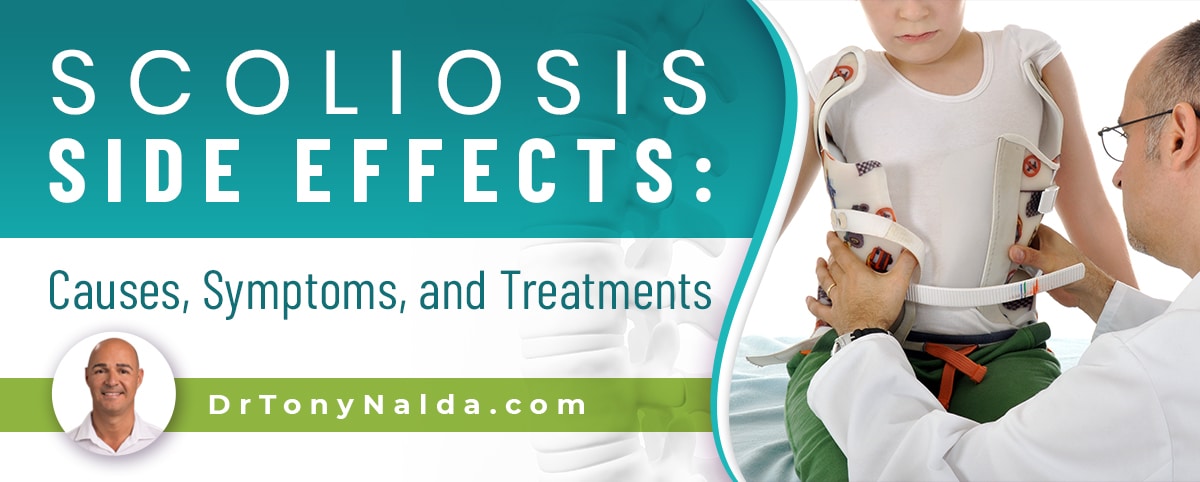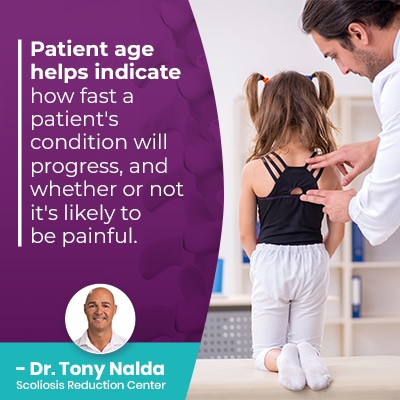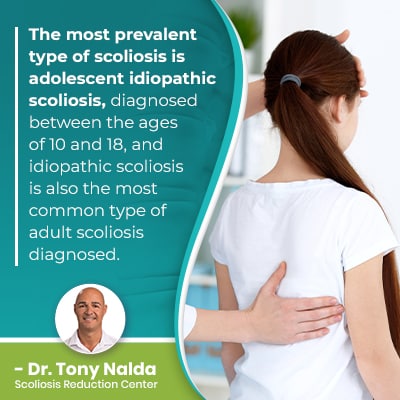Scoliosis Side Effects: Causes, Symptoms, and Treatments

Although scoliosis is a spinal condition, its effects can be felt throughout the body, especially if left untreated. When it comes to scoliosis side effects what you need to know, we're talking about the condition's early indicators, and being aware of how the different treatment options have different results in terms of preserving spinal strength and function.
Scoliosis side effects include scoliosis symptoms, and the effects of different scoliosis treatment options. Scoliosis effects will be case-specific, but commonly include postural deviation and pain, and potential treatment effects will depend on the chosen treatment approach.
We'll start with discussing why and how scoliosis is classified, as the classification points are based on key patient/condition features that shape how a patient's condition will affect them.
Table of Contents
Being Diagnosed with Scoliosis
If a person is diagnosed with scoliosis, they have developed an unnatural sideways spinal curve, with rotation, making it a 3-dimensional condition, and a minimum Cobb angle measurement of 10 degrees.
Scoliosis introduces a lot of uneven forces to the body, so it can affect in in a myriad of ways, but each patient's experience of life with their condition is going to be unique, and this is because scoliosis is such a highly-variable and complex condition to treat.
Part of the diagnostic process involves comprehensively assessing conditions, based on key patient/condition characteristics, so they can be further classified.
Classifying conditions helps streamline the treatment process and informs the crafting of effective treatment plans.
Classification points include patient age, condition type (cause), curvature location, and condition severity.
Patient Age
 Patient age helps indicate how fast a patient's condition will progress, and whether or not it's likely to be painful.
Patient age helps indicate how fast a patient's condition will progress, and whether or not it's likely to be painful.
Scoliosis is progressive, meaning it has it in its nature to worsen over time, particularly if left untreated, and growth and development is the condition's main trigger for progression.
So for children and adolescents, because they are still growing, I know they are at risk for rapid-phase progression, while I know that my adult patients are less likely to progress as quickly.
In addition, how painful a condition is is also related to patient age because scoliosis doesn't become a compressive condition until adulthood, when skeletal maturity has been reached.
In younger patients whose spines are still growing, the constant lengthening motion of growth counteracts the compressive force of the unnatural spinal curve, and it's compression of the spine and its surrounding muscles and nerves that causes the majority of condition-related pain.
So how scoliosis is going to affect the body in terms of pain is different from patient to patient, but age is a big contributing factor.
Condition Type
In addition to scoliosis ranging widely in severity, there are also different types a person can develop.
Condition type is determined by its underlying cause and is another classification point that shapes how scoliosis affects the body and will respond to treatment.
Idiopathic Scoliosis
 The most prevalent type of scoliosis is adolescent idiopathic scoliosis, diagnosed between the ages of 10 and 18, and idiopathic scoliosis is also the most common type of adult scoliosis diagnosed.
The most prevalent type of scoliosis is adolescent idiopathic scoliosis, diagnosed between the ages of 10 and 18, and idiopathic scoliosis is also the most common type of adult scoliosis diagnosed.
The most common symptoms in adolescent idiopathic scoliosis involve postural deviation, caused by the condition's uneven forces disrupting the body's overall symmetry and can include:
- Uneven shoulders
- Uneven shoulder blades
- The development of a rib arch
- An uneven waistline
- Uneven hips
- Arms and legs that appear to hang at different lengths
Additional condition indicators to watch out for in adolescents include clothing suddenly becoming ill-fitting, increasing lethargy, changes to gait, balance, and/or coordination.
The idiopathic designation means not clearly associated with a single-known cause, and idiopathic scoliosis accounts for approximately 80 percent of known diagnosed scoliosis cases; the remaining 20 percent are associated with known causes: neuromuscular scoliosis, congenital scoliosis, degenerative scoliosis, and traumatic scoliosis.
Neuromuscular Scoliosis
Neuromuscular scoliosis (NMS) is caused by the presence of a larger neuromuscular condition such as cerebral palsy, muscular dystrophy, and spina bifida, to name a few.
These neuromuscular conditions disrupt brain-body communication, and this effects the muscles and/or connective tissues that surround the spine and have to provide it with support and stabilization.
Because neuromuscular scoliosis has a larger underlying neuromuscular condition as its cause, the treatment process is complicated and has to be guided by the underlying neuromuscular condition.
Many patients with NMS have severe scoliosis and can be affected to the point of becoming nonambulatory and/or wheelchair-bound.
In addition, leg pain, muscle pain and muscle weakness, nerve compression, and breathing problems can develop due to the condition's severity.
Congenital Scoliosis
Congenital scoliosis is another rare form affecting approximately 1 in 10,000.
Infants are born with the condition as there is a malformation in the spine itself that develops in utero.
Vertebrae can be more triangular in shape than rectangular, which they should be, so can't be stacked neatly on top of one another and maintain the spine's natural curves and alignment.
In addition, malformations can occur when vertebrae fail to separate and form into distinct vertebral bodies, instead becoming fused together as one solid bone.
When it comes to treating scoliosis in infants, there are often additional abnormalities related to malformations within the body, and treatment needs to be adjusted to address the unique challenges of treating such young patients.
Degenerative Scoliosis
After idiopathic scoliosis, degenerative scoliosis is the most common type of adult scoliosis and is caused by natural age-related spinal degeneration, the rate of which can be increased, or decreased, based on the cumulative effect of certain lifestyle choices.
Carrying excess weight, leading a sedentary lifestyle, chronic poor posture, and repeatedly lifting heavy objects incorrectly can increase the rate of age-related spinal degeneration.
In most cases, degenerative disc disease is part of a degenerative scoliosis diagnosis as it's the intervertebral discs that are commonly the first spinal structures to show the effects of deterioration.
Degenerative scoliosis develops in adults as they age, most often after the age of 40, and while each case is unique, the most noticeable effect is often pain, and this is due to compression of the spine and its surrounding muscles and nerves.
When there is a degree of nerve involvement, back pain won't just be localized, but can also be radicular and felt throughout the body, often in the hands and feet.
When it comes to treating degenerative scoliosis, the goal is to prevent further deterioration, preserve spinal function, stabilize the spine, and reduce the curve back to where it was prior to causing noticeable symptoms like pain.
Traumatic Scoliosis
Traumatic scoliosis, as the name suggests, is caused by a trauma experienced by the spine, such as in a car accident or fall.
In addition, tumors pressing on the spine can also cause traumatic scoliosis by forcing the spine out of alignment.
Treatment has to address the original trauma: the underlying cause of the scoliosis development.
Now that we've talked about the different types of scoliosis, plus some of the ways they affect the body, and their different treatment needs, let's talk generally about the two main scoliosis treatment approaches, and some of their effects.
How Different Scoliosis Treatment Options Affect Patients
There are two main scoliosis treatment approaches, and they offer patients different potential outcomes in the different ways they affect the spine and its overall health and function.
Traditional scoliosis treatment has been in place for many years and commonly funnels patients towards spinal fusion surgery; a modern conservative treatment approach helps patients experience significant relief and avoid surgical treatment through proactive chiropractic-centered treatment.
Again, while each case is unique, these different approaches offer different potential outcomes that can affect quality of life because of how they affect the spine.
Let's start with traditional scoliosis surgery.
Spinal Fusion Surgery
Traditional treatment doesn't actually have a strategy for treating scoliosis while mild, so it watches and waits for signs of progression, which as a progressive condition, we know it's going to do, and then responds once conditions have progressed into the severe classification.
In severe cases undergoing traditional treatment, and when there are signs of continued progression, a patient becomes a surgical candidate and commonly has spinal fusion recommended to them.
While there are different types of spinal fusion surgery, and all surgical treatment options come with their share of risks, spinal fusion is a costly and invasive surgery that comes with some heavy potential risks and side effects.
The surgical method involves fusing the most-tilted vertebrae of the curve into one solid bone, and sometimes using bone grafts, and this is to eliminate movement in that area of the spine, meaning it can't increase in size and progress, and metal rods attached to the spine with screws hold it in place.
The hardware attached is permanent, and if there are any issues with the hardware, the only recourse is further surgery.
Now, the spine being held in place by artificial means is not the same as achieving actual corrective results, in the form of a structural curvature reduction, and an effect that many patients are disappointed with post spinal fusion treatment is the loss in spinal flexibility and range of motion.
Due to the stiffness and immoveable nature of the spine's fused section, the surrounding muscles can also become sore, weak, and painful.
In addition to a spine that's less moveable and flexible, additional side effects associated with spinal fusion surgery include:
- Risk of infection
- Excessive bleeding
- Nerve damage
- Pain at the fusion site
- A spine that's more vulnerable to injury
- Disappointing cosmetic results
- Emotional effect of living with a fused spine
While not everyone undergoing spinal fusion is going to experience these effects, the risk is there so should be considered carefully, and conservative treatment offers patients a less invasive form of treatment that strives to preserve as much of the spine's natural function as possible.
Conservative Chiropractic-Centered Scoliosis Treatment
Here at the Scoliosis Reduction Center, I believe in helping people with scoliosis avoid surgical treatment.
By integrating multiple condition-specific treatment disciplines like chiropractic care, physical therapy, corrective scoliosis bracing, and custom-prescribed home exercises, I can help patients experience significant relief from symptoms by addressing their underlying cause: the condition itself.
While traditional treatment values watching and waiting and is more reactive, a conservative approach involves proactive treatment started as close to the time of diagnosis as possible.
While there are no treatment guarantees, treating scoliosis while it's mild means there are fewer limits to what we can achieve; scoliosis is simpler to treat when the curve is small, before progression has increased spinal rigidity, making it less responsive to treatment, and before the body has had ample time to adjust to the unnatural spinal curve's presence.
As a structural condition, scoliosis has to be impacted, first and foremost, on a structural level, and I do this through scoliosis-specific chiropractic care, which includes a number of techniques and manual adjustments that can adjust the position of the curve's most-tilted vertebrae back into alignment with the rest of the spine.
Addressing any areas of vertebral subluxation means restoring the natural spinal curves and alignment, and improving spinal biomechanics, health, and function.
What I want patients, and their families, to understand is that there is more than one way to stop curve progression, and the reality is that most cases of scoliosis can be treated nonsurgically, especially those that are diagnosed and treated early.
So the way in which successful conservative treatment affects the spine is in preserving as much of its natural function as possible, through non-invasive treatment that impacts the condition's underlying structural nature, and increasing core strength so the spine can be optimally supported by its surrounding muscles.
Conclusion
I've treated all types and severity levels of scoliosis from idiopathic scoliosis to different forms of adult scoliosis, scoliosis patients with mild scoliosis, scoliosis in older adults, and childhood scoliosis.
In severe cases, and in most cases of scoliosis in adults, pain relief is a focus of treatment as an unnatural curvature of the spine causes compression of the spine and its surrounding muscles and nerves.
In most adult scoliosis patients, the treatment goal is to reduce the spinal deformity back to where it was prior to becoming symptomatic, using chiropractic care to adjust the position of the vertebrae, physical therapy to increase core strength, and a rehabilitation program to further stabilize the spine.
The best way to alleviate pain, as a scoliosis symptom, is to address its underlying cause: the structural spinal condition itself, and by being proactive with treatment, progression, escalating symptoms, and the need for surgical treatment can be prevented.
While there is still a place for spinal fusion in scoliosis treatment, I want patients to be aware of all treatment options available to them, and the risks and side effects associated with posterior spinal fusion that should be considered carefully.
Reducing unnatural spine curves on a structural level is the goal of the Center's treatment, and by being proactive, the condition's effects can be minimized, along with the need to treat scoliosis through invasive surgery.
Dr. Tony Nalda
DOCTOR OF CHIROPRACTIC
After receiving an undergraduate degree in psychology and his Doctorate of Chiropractic from Life University, Dr. Nalda settled in Celebration, Florida and proceeded to build one of Central Florida’s most successful chiropractic clinics.
His experience with patients suffering from scoliosis, and the confusion and frustration they faced, led him to seek a specialty in scoliosis care. In 2006 he completed his Intensive Care Certification from CLEAR Institute, a leading scoliosis educational and certification center.
About Dr. Tony Nalda
 Ready to explore scoliosis treatment? Contact Us Now
Ready to explore scoliosis treatment? Contact Us Now





